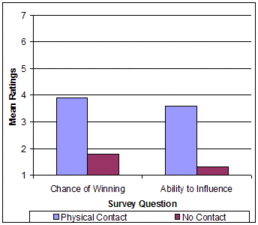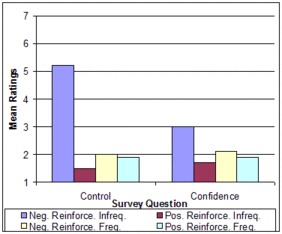The Curse of the Bambino1 has notched another year in its proverbial belt. As Red Sox fans mourn their losses and Yankees fans exult in yet another triumph, few on either side can help but mention the Curse. The Curse is but one of a wealth of superstitions rampant in baseball. Just watch Nomar Garciaparra’s pre-batting rituals, Roger Clemens’ kissing of the Babe’s monument before every game he pitches at Yankee Stadium, or any diehard fan’s strategic use of the rally cap2. This year, the potential World Series match-up between two teams who haven’t seen a World Series win since the days of Woodrow Wilson brought these superstitions out in force: there are reports of Red Sox fans leaving bribes at Babe Ruth’s grave – beer, pocket change, cigars, and even a pacifier – all in hope of lifting the Babe’s Curse (Associated Press, 2003).
Research shows that the Curse might be explained by two similar cognitive fallacies: 1) illusory correlation; and 2) illusory control (see Toneatto, 1999). Illusory correlation is our tendency to assign causality where none exists. Illusory control is the belief in our ability to influence events over which we have no control. Both lead to superstitious behavior and magical thinking. In the case of the Bambino, illusory correlation led to the legend of the Curse in the first place, and illusory control is responsible for the collection of payoffs at the Babe’s grave this year. This week’s WAGER reviews two studies that suggest that these baseball players and fans are not as unique in their behaviors as one might imagine. Players, fans and gamblers often share similar cognitive fallacies.
Illusory correlation. Aeschleman, Rosen, and Williams (2003) asked 40 participants to sit at a computer and use a keypad either to make the word “bad” disappear from a computer screen (preventers) or to make the word “good” appear (promoters). Participants’ key presses actually were irrelevant to the presentation of words, which appeared frequently for some participants and infrequently for others. Preventers in the less frequent condition reported their ability to influence the word on the screen and their confidence that they had discovered the right keypad sequence as much higher than did participants in the other conditions, F(1,36) = 29.94, p < .05, and F(1,36) = 4.78, p < .05, respectively (see Figure 1).
Figure 1: Perceived ability to control stimulus and confidence in method used in frequent and infrequent negative (word = “bad”) and positive (word = “good”) reinforcement conditions (Aeschleman et al., 2003).
Aeschleman et al. explained these results as providing evidence that when presented with reinforcement for a behavior (i.e., the word “bad” failing to appear on the screen after attempting to keep it off the screen), people acquire superstitious beliefs, inferring causality without adequate proof. More specifically, their results imply that people are more likely to respond superstitiously when their behavior co-occurs with the prevention of an infrequent event than when it cooccurs with the promotion of a frequent event. Returning to the world of baseball, the behavior observed in this study is similar to the belief of many fans and announcers that the mention of a no-hitter will jinx the pitcher and prevent its occurrence (or that the assurance that “this year we’ll break the Curse” will doom the Red Sox to another year of failure). Since both a no-hitter and a World Series victory are rare occurrences, these beliefs are likely to be reinforced.
Illusion of Control. Wohl and Enzle (2002) proposed that the means by which people believe themselves to have control over a chance event (i.e., an event they cannot actually influence) is through sympathetic magic – causal forces (such as personal luck) outside physical reality. To test this hypothesis, they designed a wheel of fortune game in which participants chose a numbered ball and received a reward if the wheel of fortune landed on that number. Participants (N = 60) were either allowed or not allowed to handle the ball they had chosen. During the wheel spin, participants rated how likely they were to win and how much influence they believed they had over the outcome. As Figure 2 shows, participants who were allowed to touch the ball were significantly more confident that they would win, and rated their ability to influence chance events as significantly higher than those who were not allowed to touch the winning ball, F(2,42) = 14.58, p < .001, and F(2,42) = 15.18, p < .001, respectively. These results imply that when people perceive that they have some aspect of control in a situation, however irrelevant (e.g., holding a numbered ball), they believe that their personal luck can influence the outcome of an event. Returning to the baseball analogy, it is not enough to want our team to win or our pitcher to get that crucial out. We need rituals – wearing our rally caps, providing offerings to the Babe
-to transform those desires into reality.
Figure 2: Perceived chance of winning and ability to influence chance events (Wohl & Enzle, 2002). 
Both of the studies described above are limited in their applicability to settings outside the lab. Aeschleman et al.’s finding that negative reinforcement is more likely to produce illusory correlation than positive reinforcement might be specific to the conditions in their paradigm. For example, they did not ask whether participants believed that they had discovered a keypad sequence that caused the outcome they did not want (“bad” appearing or “good” disappearing), and yet many superstitions in real life involve avoiding certain behaviors, not engaging in them. In both studies, the stakes were low, leaving unanswered whether superstitious beliefs increase or decrease as outcomes become more important.
Two very common human tendencies underlie the results of these studies. We tend to jump to conclusions of causality and contingency without proper evidence and attempt to control our environment even when no control is possible. These cognitive strategies are functional when they serve to reduce anxiety by garnering illusory control, but can lead to sometimes humorous and sometimes disordered behavior when unchecked. What might begin as a need to close one’s eyes and hum every time Manny Ramirez is up to bat reflects similar cognitive processes to the conviction that a “lucky” slot machine will eventually pay off or that self-picked lottery numbers will be sure to win… or even that one can bet big because the streaking Red Sox have to win next year. Don’t bet on that, either.
Comments on this article can be addressed to Sarah Nelson.
Notes
1. In 1918, the Boston Red Sox won their fifth World Series since the post-season ritual began in 1903, led by a dominant pitcher by the name of Babe Ruth (or the Bambino). The Yankees, to that point, had not won a series. Two years later, the Red Sox traded that pitcher away to New York. Since then, the Red Sox have not won a World Series and the Yankees have gone on to win 26. This record, and the notable bungles and collapses that have kept it going, has come to be called the “Curse of the Bambino.”
2 A rally cap is any hat worn inside out or flipped up, most often during the late innings of a baseball team to encourage a rally from the losing team.
References
Aeschleman, S. R., Rosen, C. C., & Williams, M. R. (2003). The effect of non-contingent negative and positive reinforcement operations on the acquisition of superstitious behaviors. Behavioural Processes, 61, 3745.
Associated Press. (2003). Sox fans try to exorcise demons with offerings to Ruth. Brattleboro Reformer.
Rogers, P. (1998). The cognitive psychology of lottery gambling: A theoretical review. Journal of Gambling Studies, 14(2), 111-134.
Toneatto, T. (1999). Cognitive psychopathology of problem gambling. Substance Use & Misuse, 34(11), 1593-1604.
Wohl, M. J. A., & Enzle, M. E. (2002). The deployment of personal luck: Sympathetic magic and illusory control in games of pure chance. Personality and Social Psychology Bulletin, 28(10), 1388-1397.





